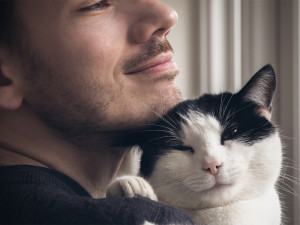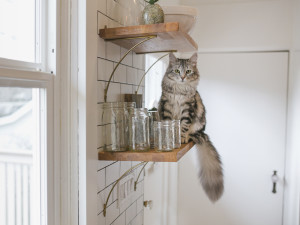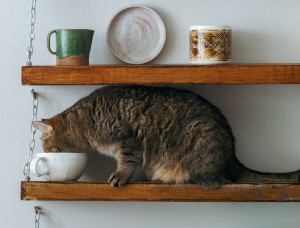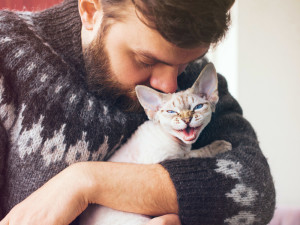Speech Buttons Aren’t Just for Dogs — Cats Are Chiming In, Too
Cat behaviorist Kristiina Wilson and her viral cat, Steve, are successfully communicating with speech buttons.

share article
In our hours mindlessly scrolling through social media, most of us have encountered a new brand of viral video that elicits awe, skepticism, or both: a bright-eyed dog pressing buttons to communicate their needs and emotions. We should have anticipated that our cats wouldn’t tolerate being left out of the conversation; sure enough, cats can use speech buttons, too, and they’ve taken to our TikTok feeds to prove they’re as eloquent as dogs (take that, Bunnyopens in a new tab!). Certified cat behaviorist Kristiina Wilsonopens in a new tab ’s tuxedo cat Steveopens in a new tab is one of the most popular chatty cats on TikTokopens in a new tab, with some videos garnering more than four million views.
Wilson started using the buttons in college, when she was bored during quarantine. She was working on her master’s thesis on animal behavior, and she decided to do an adjacent experiment just for kicks. Her cat, Steve, had always seemed communicative, and she’d seen videos of animals using buttons online, so Wilson decided to give it a go. He took to it right away — within just four days, he’d learned how to ask to go outside.
Speech Buttons Won’t Turn Your Cat Into a Wordsmith
Wilson emphasizes that, though the idea of our pets learning English is alluring, using these buttons doesn’t actually indicate speech acquisition. Sorry — your cat won’t be writing you thank-you notes when you clean out their litter any time soon (fat chance they would do that anyway).
“It’s the same thing as when people have dogs and they teach them to ring a bell when they want to go outside,” Wilson says. “You’re teaching an animal to associate a concept with an object, which in this case is a button. Steve doesn’t necessarily speak English; he just associates each button with a different thing that he gets. We have to be careful to remember that he’s not saying, ‘Oh, hey, I want to go outside’ — what he thinks the outside button represents could actually be the door opening or sky or fresh air. There’s no way to know what he thinks ‘outside’ means. That’s why I encourage people to not use concepts or words that are overly complicated, such as emotion-laden words. It’s going to be difficult to teach an animal an association with something like ‘I love you’ or ‘mad’ or things like that.”
That said, Wilson doesn’t want to rag on people whose videos are more emotionally focused. “On social media, it’s all for entertainment,” she says. “I think it’s wonderful that so many people are doing this because it makes them pay more attention to their pet and their pet’s needs. I do think that when you get into sentences and stuff like that, there’s a lot of confirmation bias happening on the part of the owner. And just speaking as a scientist, I always want to be careful of that.”
Some Tips for Button Work With Cats
If you’re interested in using buttons with your own cats, Wilson has a few tips. She recommends using buttons if your cat seems eager to communicate — all cats are different, and more aloof ones might never learn. “With Steve, it was always very obvious what he wanted — like when he wanted to go outside previous to having the buttons, he would go to the door and jump at the handle and yell,” Wilson says.
She also recommends not starting with feed-based words, because those are likely to make your pet associate all the other buttons with food. Instead, find another one of your cat’s most high-valued items. “Like, what’s the thing they’re obsessed with?” Wilson poses. “For Steve, that was outside. But maybe you have a pet who really values pets or snuggles or whatever it is. Use that to model your first word.”
Once they’ve learned one word, they’ve learned the basic concept of a speech button, and the rest will be much easier to teach. Just remember: When it comes to emotional affirmations, it’s probably best to let your cat tell you they love you in more subtle ways, like a slow blink or a dead bug deliveryopens in a new tab.

Sio Hornbuckle
Sio Hornbuckle is a writer living in New York City with their cat, Toni Collette.
Related articles
![cat snuggling man]() opens in a new tab
opens in a new tabWhat’s Your Cat’s Love Language?
Five surprising ways cats show affection (and how you can show it back), according to a cat behaviorist.
![A cat sitting on a shelf with glassware.]() opens in a new tab
opens in a new tabWhy Do Cats Knock Stuff Over?
Your brand new iPhone, antique figurine, full glass of water—they will swat it off the table. A cat behaviorist explains why.
![Gray cat sniffing a glass on a shelf]() opens in a new tab
opens in a new tabHow to Scent Train Your Cat
A veterinarian on how nosework and scent enrichment can strengthen your bond.
![cat meowing]() opens in a new tab
opens in a new tabWhy Does My Cat Meow So Much? Reasons Your Cat Meows Excessively
How to decode your cat’s love language when one meow has many meanings.



